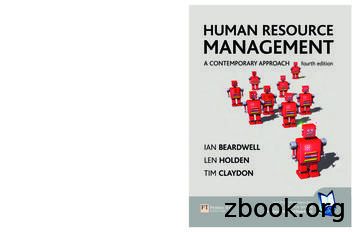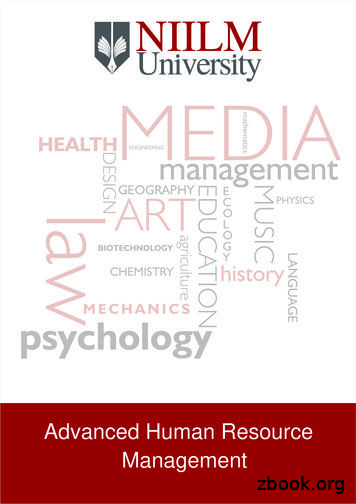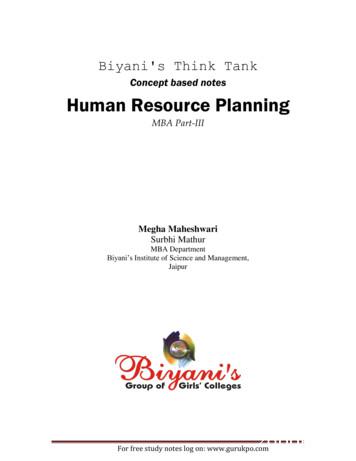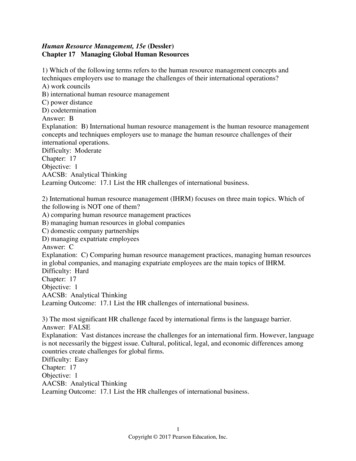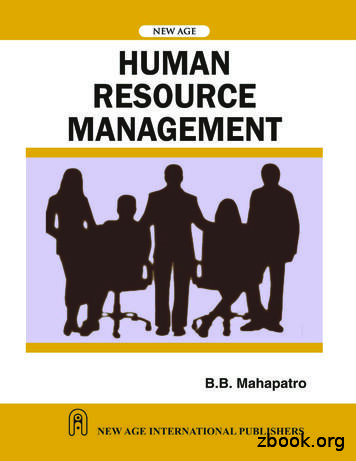HUMAN RESOURCE MANAGEMENT HUMAN RESOURCE
HUMAN RESOURCE MANAGEMENTHUMAN RESOURCEA CONTEMPORARY APPROACH fourth editionIAN BEARDWELLLEN HOLDENTIM CLAYDONA thorough introduction to the subject, Human Resource Managementcontains a variety of perspectives, styles and arguments. Its rigorous,critical approach is made accessible to students through theconsistent chapter structure and increased features such as: learning outcomes and chapter summaries activities ‘stop and think’ features UK, International and European case studiesEditors: Professor Ian Beardwell – former Headof the HRM Department, Dr. Len Holden –Principal Lecturer in HRM and Dr. Tim Claydon –Principal Lecturer in Industrial Relations –Leicester Business School, De Montfort University.Contributors: Phil Almond, Julie Beardwell,Dr. Ian Clark, Professor Audrey Collin, TrevorColling, Mike Doyle, Linda Glover, NickyGolding, Dr. Sue Marlow, Professor Mike Noon,Julia Pointon, Alan Ryan, Olga Tregaskis – All ofthe Department of Human Resource Management,Leicester Business School, De Montfort University. glossary, extensive references and further reading bright, full colour interior design.Other features include a companion website with multiple choicequestions for each chapter, Internet exercises, annotated weblinks anda searchable online glossary. There is also an interactive online courseto accompany the book. All this can be found at www.booksites.net,under the subject or author’s name.fourtheditionScreen shot reprinted by permission from Microsoft Corporation.‘Human Resource Management clearly explains and critiques current theory and then illustrates it withrelevant examples, making it useful for both undergraduate and postgraduate students.’Stephanie Tailby, Principal Lecturer, HRM, Bristol Business SchoolAn imprint ofwww.pearson-books.comBEARDWELLHOLDENCLAYDONAs with previous editions, Human Resource Management is in line withCIPD standards and the critical approach and sophisticated writingstyle is suitable for undergraduates, HRM Masters students andspecialist MBAs.HUMAN RESOURCE MANAGEMENTThe fourth edition of this classic, thought-provoking textbook fromDe Montfort University, edited by Ian Beardwell, Len Holden and TimClaydon, has been updated and revised throughout.A CONTEMPORARY APPROACH‘This book is deservedly established as one of the leading textbooks on the subject. The various contributorsall provide clear and understandable expositions of their often complex topics, but without sacrificingacademic rigour and standards. The book is an essential resource for the teaching and learning of HRM.’Professor Jim Stewart, Department of Human Resource Management, Nottingham Business SchoolMANAGEMENTA CONTEMPORARY APPROACHfourth editionIAN BEARDWELLLEN HOLDENTIM CLAYDONUse the online resourcesfor this book atwww.booksites.net/beardwell
8904 HRMA A01.QXD22/10/033:56 pmPage iHUMAN RESOURCEMANAGEMENT
8904 HRMA A01.QXD22/10/033:56 pmPage iiAbout the Companion WebsiteVisit the HUMAN RESOURCE MANAGEMENT Companion Website atwww.booksites.net/beardwell to access a rich, free resource of valuable teaching andlearning material, including the following content:General How to use this book, which outlines suggested routes through the book for MBA, MA/MSc andCIPD students About the authors section, with brief descriptions of the author team’s academic credentials A full table of contents Book features, explaining what’s new and what’s changed in this new editionFor the Lecturer A secure, password-protected site offering downloadable teaching supportCustomisable PowerPoint slides, including key figures and tables from the main textA fully updated Lecturer’s Guide to using the book as a supplement to your own resourcesExtra case studiesLearning objectives from each chapterFor the Student Internet exercises for self study, complete with suggested answersExtra self-check questionsSearchable online glossaryMultiple choice questions for every chapter, with instant feedbackAnnotated weblinks, both to relevant professional bodies and to specific, useful Internetresources to facilitate in-depth independent researchOnline CourseAlso available with this text is access to integrated, easy-to-use Online Course content for use withCourse Compass, Blackboard or Web CT. It contains 40 hours of interactive material. For furtherinformation visit www.booksites.net and search under the subject or author’s name.
8904 HRMA A01.QXD22/10/033:56 pmPage iiiHUMAN RESOURCEMANAGEMENTA CONTEMPORARY APPROACHFourth EditionEdited byIan Beardwell, Len Holdenand Tim ClaydonDe Montfort University, Leicester
8904 HRMA A01.QXD23/10/034:45 pmPage ivPearson Education LimitedEdinburgh GateHarlowEssex CM20 2JEEnglandand Associated Companies throughout the worldVisit us on the World Wide Web at:www.pearsoned.co.ukFirst published in Great Britain in 1994Second edition published in 1997Third edition published in 2001Fourth edition published in 2004 Longman Group Limited 1994 Financial Times Professional Limited 1997 Pearson Education Limited 2001, 2004All rights reserved. No part of this publication may reproduced, stored in aretrieval system, or transmitted in any form or by any means, electronic, mechanical,photocopying, recording or otherwise, without either the prior written permission ofthe publisher or a licence permitting restricted copying in the United Kingdom issuedby the Copyright Licensing Agency Ltd, 90 Tottenham Court Road, London W1T 4LP.All trademarks used herein are the property of their respective owners. The use ofany trademark in this text does not vest in the author or publisher any trademarkownership rights in such trademarks, nor does the use of such trademarks implyany affiliation with or endorsement of this book by such owners.ISBN 0 273 67911 2British Library Cataloguing-in-Publication DataA catalogue record for this book is available from the British Library10 9 8 7 6 5 4 3 2 108 07 06 05 04Typeset in 10pt Sabon by 30Printed and bound by Scotprint, HaddingtonThe publisher’s policy is to use paper manufactured from sustainable forests.
8904 HRMA A01.QXD22/10/033:56 pmPage vProfessor Ian Beardwell 1946–2002In memoriamSadly, Ian Beardwell died suddenly just after work had begun onthis edition. Ian made a great contribution to the study andpractice of HRM through his research and writing, his teaching,and his close engagement with the Chartered Institute of Personneland Development, where he was Vice-President for Membershipand Education from 1997 to 2001. Part of that contribution washis role in developing an HRM textbook that was scholarlyand critical in its approach, yet accessible to students.This edition of that book is dedicated to his memory.
8904 HRMA A01.QXDvi22/10/033:56 pmPage viGlossary of terms and abbreviationsCONTENTSPrefaceGuided tour of the bookPlan of the bookHow to use this t 1HUMAN RESOURCE MANAGEMENT ANDITS ORGANISATIONAL CONTEXTIntroduction to Part 131 An introduction to human resourcemanagement: strategy, style oroutcomeIan Beardwell (revised by Julie Beardwelland Ian Clark)ObjectivesIntroductionSome assumptions about human resourcemanagementThe search for the defining characteristicsof HRMThe origins of human resource managementHuman resource management: the state of thedebateSummaryActivityReferences and further reading444141517242728292 Strategic human resource managementNicky GoldingObjectivesIntroduction to strategic human resourcemanagementUnderstanding the business contextApproaches to the strategy-making processThe rise of strategic human resource managementExploring the relationship between strategicmanagement and SHRM: the best-fit schoolof SHRMThe resource-based view of SHRMBest-practice SHRM: high-commitment modelsHigh-performance work practicesConclusionSummaryActivityQuestionsCase study: Jet AirlinesUseful websitesReferences and further reading495659676869697071713 Human resource management incontextAudrey CollinObjectivesIntroductionThe immediate context of HRMThe wider context of HRMWays of seeing and thinkingConclusion and a new beginning?SummaryActivityQuestionsExerciseCase study: Awkward squad promises a roughride at BlackpoolReferences and further readingPart 1 Case studyMarks and Spencer757575798491101102103104104105106110Part 2RESOURCING THE ORGANISATION32323234354142Introduction to Part 21134 Human resource management andthe labour marketTim ClaydonObjectivesIntroduction115115115
8904 HRMA A01.QXD22/10/033:56 pmPage viiContentsThe nature of labour markets and employmentsystemsExternalisation or internalisation of employment?The rise and fall of internalised employmentsystems?The future of employment systems: theoryand evidenceConclusionSummaryActivityQuestionsCase study: ‘Fears for the thread of industry’References and further reading1161201341421501511521531531545 Human resource planningJulie BeardwellObjectivesIntroductionDefining human resource planningThe traditional approach to HRPHuman resource planning – a contemporaryapproachThe advantages and disadvantages of humanresource planningHuman resource planning in practiceHRP and strategic HRMFuture directionsSummaryQuestionsCase study: ASDA and staff retentionReferences and further reading1571571571581591721811821831851861861871876 Recruitment and selectionJulie Beardwell and Mary WrightObjectivesIntroductionThe external contextThe internal contextDevelopments in the systematic approach torecruitment and ces and further reading1891891891901982042242252252272277 Managing equality and diversityMike NoonObjectivesIntroduction230230230The nature of discriminationWhy be concerned with equality and diversity?Equal opportunity policiesDevising equality and diversity policiesInstitutional discriminationThe process of discrimination in an organisationConcluding commentSummaryQuestionsCase study: Safe Future FinanceReferences and further reading231233238242248251253253254255256Part 2 Case studyEmployers exploit agency work boom258Part 3DEVELOPING THE HUMAN RESOURCEIntroduction to Part 32638 Learning and developmentAudrey CollinObjectivesIntroductionThe changing world of work and organisationsLearning and developmentThe outcomes and process of learningThe process of developmentThe organisation as context for learning anddevelopmentControversial issuesConclusionsSummaryQuestionsExercisesCase study: Appoint in haste, repent at leisureReferences and further 099 Human resource development: theorganisation and the nationalframeworkLen HoldenObjectivesIntroductionThe need for trainingCreating a human resource development planThe learning organisationHRD and the national framework for vocationaleducation and training313313313314317329333vii
8904 HRMA A01.QXDviii22/10/033:56 pmPage viiiContentsVET in the leading industrialised nationsVET in BritainControversial issuesSummaryActivityQuestionsExercisesCase study 1: Wealden District CouncilCase study 2: Smart cookiesReferences and further reading33534135035335435535535535635810 Management developmentMike DoyleObjectivesIntroductionDefining management developmentManagement development as a strategicimperativeOrganisational approaches to managementdevelopmentOrganising management developmentprogrammesImplementing and evaluating managementdevelopment programmesManagement development for different contextsand special needsThe future for management development:the need for new thinking and new practices?SummaryQuestionsExercisesCase study: Management development inMid County NHS TrustReferences and further readingPart 3 Case studyTransforming Anglian ing contractual and statutoryemployment rights45045345946046146146346312 Establishing the terms andconditions of employmentSue Marlow and Trevor ctivesIntroductionCollective bargaining – history, definitions,analyses and criticismsThe collective agreementThe development of collective bargaining inBritain 1945–80Changes in collective bargaining since the 1980sHRM and collective bargaining‘New Labour’ and the contemporaryemployment relationshipEstablishing the terms and conditions ofemployment in the public sectorEstablishing terms and conditions ofemployment in non-union organisationsSummaryQuestionsExercisesCase study: Business views two-tier workforceagreement as dynamiteReferences and further 9349449549549613 Reward and performancemanagementJulia Pointon and Alan J. Ryan11 The employment relationship andemployee rights at workIan Clark429442445447363Part 4THE EMPLOYMENT RELATIONSHIPIntroduction to Part 4The contract of employmentDiscrimination in employmentThe regulation of working timeTermination of the employment contractEnforcement of contractual and statutoryemployment rightsNew rights at work?ConclusionSummaryQuestionsCase study: The pitfalls that follow a failureof best practiceUseful websitesReferences and further readingObjectivesIntroductionThe development of reward systemsDesign and debatesMotivation as a mechanismNew day, new way, new pay?The psychological contractHRM and performance management500500500501502504517519523
8904 HRMA A01.QXD22/10/033:56 pmPage ixContentsConclusionSummaryQuestionsExercisesCase study: Widgets Are UsReferences and further reading53353453453553553614 Employee involvement andempowermentLen Holden539International HRMHRM in multinationalsConclusionSummaryQuestionsCase study: All change at LinkzReferences and further reading16 Human resource management andEuropeLen Holden and Tim ClaydonObjectivesIntroductionHRM and employee involvementEmployee involvement and communicationEmpowermentControversy: does employee involvement work?The case of TQMInternational aspects of employee involvementSummaryActivityQuestionsExercisesCase study 1: Total quality managementCase study 2: Empowerment at SemcoReferences and further readingPart 4 Case studyMalone Superbuy rt 5INTERNATIONAL HUMAN RESOURCEMANAGEMENTIntroduction to Part 558515 HRM in multinationals: a comparativeinternational perspectivePhil Almond, Ian Clark and Olga TregaskisObjectivesIntroductionNational business systems (NBSs)Comparative ntroductionEuropean Union issuesThe Social CharterEastern EuropeSummaryActivityQuestionsCase study: A human resource strategy forEuropump LtdReferences and further reading63763763763864466466966967067067217 Human resource management in AsiaLen Holden and Linda GloverObjectivesIntroductionJapan: economic growth and HRMChina: economic growth and HRMHong Kong: economic growth and HRMSouth Korea: economic growth and HRMSingapore: economic growth and HRMSummaryActivityQuestionsCase study: Yummee BiscuitsReferences and further reading675675675677684695697702705706707707709Part 5 Case studyGlobal and local: the case of the inoperableHRM strategy712Glossary of terms and abbreviationsIndex714722ix
8904 HRMA A01.QXD22/10/033:56 pmPage xGlossary of terms and abbreviationsPREFACEI know that Ian Beardwell was as surprised as the rest of the writing team by the factthat this book reached four editions. In doing so it has reflected developments in thefield of Human Resource Management over a decade. It will also serve as a monumentto Ian in that the book played a modest role in shaping conceptions and understandingin the thoughts of a large number of students and lecturers. A textbook, while reflectingon and critiquing the leading edge in HRM research, also acts as an interpreter of oftencomplex trends. We hope that this edition maintains the analytical and critical standardof previous ones.Since the first edition of this book the role and function of human resource management within organisations have become more complex and the issues and policies whichhave become associated with it have multiplied considerably. The continuing devolvementof HRM functions to line managers has had some commentators predicting the death ofthe personnel/HRM department and in the second edition there was consideration of theimportant questions about the role of the HRM professional in changing organisations.The second and third editions raised concerns about strategic policy-making and thestrategic nature of not only HRM, but those areas and disciplines associated with it, suchas human resource development (HRD), management development and performancemanagement. It also examined the role and nature of HRM in relation to culture changeschemes such as total quality management (TQM), customer service programmes, business process re-engineering (BPR), investors in people (IIP) and performance-related pay(PRP). These add to the role confusion and uncertainty for HRM practitioners, as well asfor middle and line managers and supervisors with expanded HRM functions. The thirdedition also reflected on the rise in popularity of the learning organisation and its sisterconcept the knowledge-based organisation as well as empowerment initiatives, all ofwhich constitute types of organisational style and culture and exist as entities withinthemselves resting on HRM and related practices.HRM has also become more ambiguous in relation to other managerial initiativeswhich place emphasis on employee flexibility and teamwork aimed at enhancing commitment through empowerment policies. The contradictions inherent in its role andfunction remain, not least in the conflicting ethical positions which are often posed bychanging economic circumstances. A decade of growth in HRM popularity has alsorevealed its changing nature. There is less interest in finding a universal paradigm ormodel of HRM than in understanding how it operates in diverse situations and whatcontribution it can make to the effectiveness and the profitability of the organisation.In addition, the growing uncertainties of work in the flexibilised world of portfolioand vendor workers aligned with the decreasing core of permanent employees has alsodirectly and indirectly impacted on HRM policy, posing new forms of employee relationsassociated with short-term contracts, part-time working, agency and outsource working.The inconstancy of the organisational form is continually reshaping HRM role andpolicy, and HRM models rooted in the certainties of previous decades no longer apply.The history of the employment relationship over the past decade and a half indicatessome kind of ‘managerial revolution’ and within this movement the influence of HRMhas not been small. The role and function of HRM beyond the millennium have continued to evolve, fuelling debate amongst practitioners and academics. What is and will
8904 HRMA A01.QXD22/10/033:56 pmPage xiPrefaceremain certain is the working out of its role and function against a backdrop of contradictory and in some cases conflicting change, which is part of the inherent dynamics ofglobal capitalism.We have sought to add new areas to the book. Most notably, a chapter on the developments in strategic HRM critically examines concepts such as high-performance worksystems, the resource-based view of HRM, the balanced scorecard concept and ‘bundles’of HR policies. In this edition these concepts are explored much more fully. While equalopportunities has always been part of previous editions we offer a new chapter thatdevotes itself entirely to this in the context of what is now increasingly being retitled‘managing diversity’. There is also a new chapter on international HRM which examines it from an institutional and business systems perspective, and reshapes and updatesthe international organisational context of HRM. There is a new chapter on humanresource planning and, while the chapter on job design has been dropped, this has beenbriefly tackled in the chapter on employee involvement. There is a totally new chapteron the important area of
Human resource management: the state of the debate 24 Summary 27 Activity 28 References and further reading 29 2 Strategic human resource management Nicky Golding 32 Objectives 32 Introduction to strategic human resource management 32 Understanding the business context 34 Approaches to the strategy-making pr
Human Resource Management Question Answer Bank MBA-203 Q.1 What is Human Resource Management Human Resource Management is a process, which consists of four main activities, namely, acquisition, development, motivation, as well as maintenance of human resources. Scott, Clothier and Spriegel have defined Human Resource Management as that
1.1.2 Evolution of Human Resource Management 1.1.3 Human Resource Management: Nature 1.1.4 Human Resource Management: Scope 1.1.5 Human Resource Management: Objectives 1.2 Functions of HRM 1.3 Growing Importance of HRM Functions 1.3.1 Factors Contributing to the Growing Importance of HRM 1.4 Concepts and Essential of Management
Human Resource Management Human Resource Policy QUADRANT-I Module 4: Human Resource Policy 1. Learning Outcome 2. Definition 3. Employee understanding on HR Policy 4. Benefits of policy 5. Specific Personal policies 6. Responsibility for policy making 7. Formulation of Human Resource Policy 8. Principles 9. Procedures 10. Programs 11. Summary 1.
Ans Human resource planning can be defined as the process of identifying the number of people required by an organization in terms of quantity and quality. All human resource management activities start with human resource planning. So we can say that human resource planning is the principle/primary activity of human resource management.
human resource functions while keeping them satisfied in their work. It covers a wide range of chapters on human resource management such as human resource functions, performance management and human resource development and empowerment. This module serves the purpose of a resource handbook for carrying out training on Human Resource Management
B) international human resource management C) power distance D) codetermination Answer: B Explanation: B) International human resource management is the human resource management concepts and techniques employers use to manage the human resource challenges of their international
1.3 Definition of Human Resources Management 3 1.4 A New Mandate for Human Resources 4 1.5 Changing Role of the Human Resource Management 5 1.6 Managing human resources in the emerging scenario 7 1.7 Evolution of Management of Human Resources: An Indian Perspective 10 References 16 2. THE CONCEPT, SCOPE AND FUNCTION OF HUMAN RESOURCE OF .
answer choices you are marking on your answer sheet.-4-GO ON TO THE NEXT PAGE Language Arts – Reading Time — 25 minutes 19 Questions GO ON TO THE NEXT PAGE -5-GO ON TO THE NEXT PAGE A violent storm has threatened the first voyage of the ship Nan-Shan. This excerpt from a work of fiction portrays several crew members, including the first mate, Jukes, as they confront the storm. Jukes was as .
